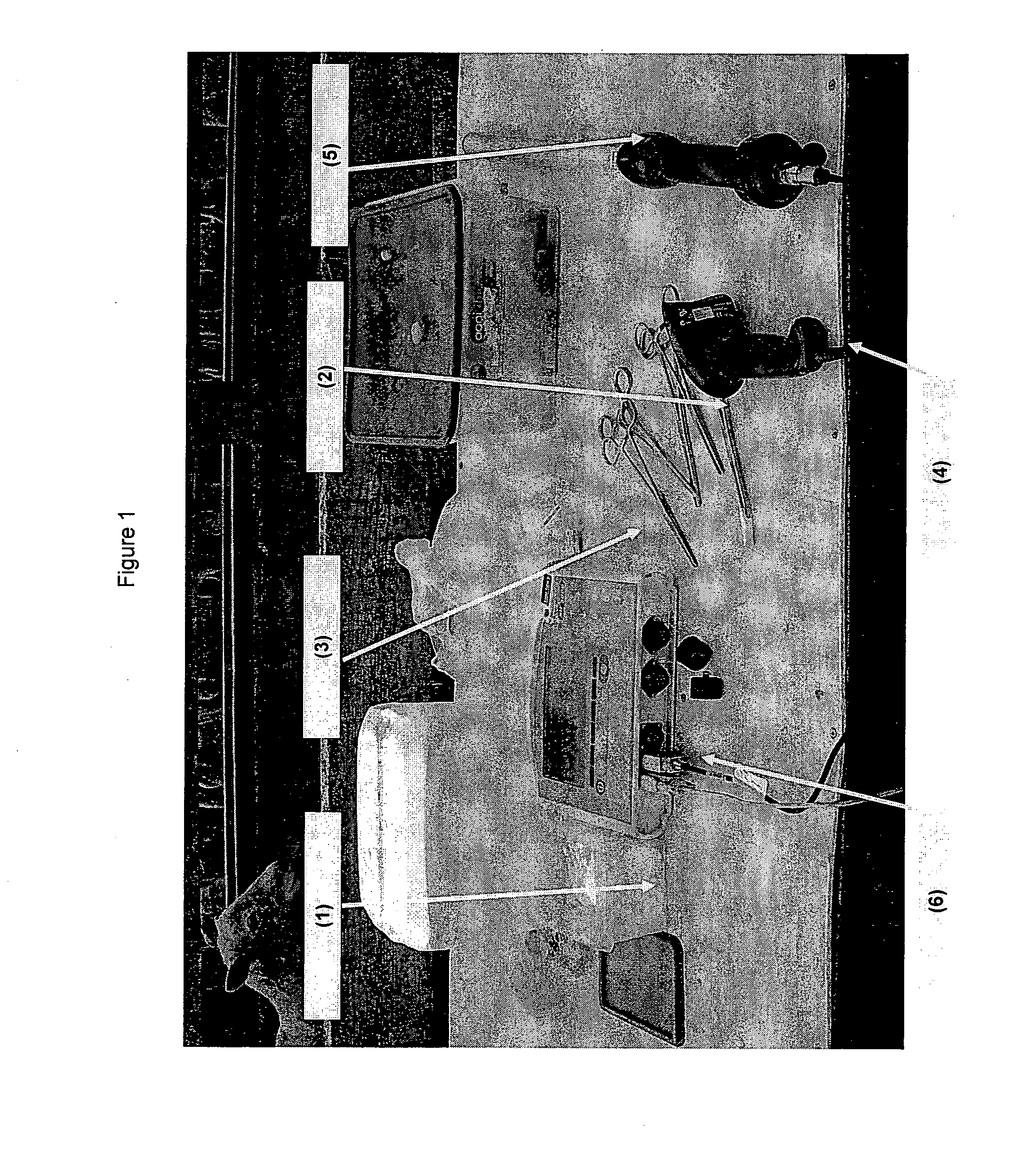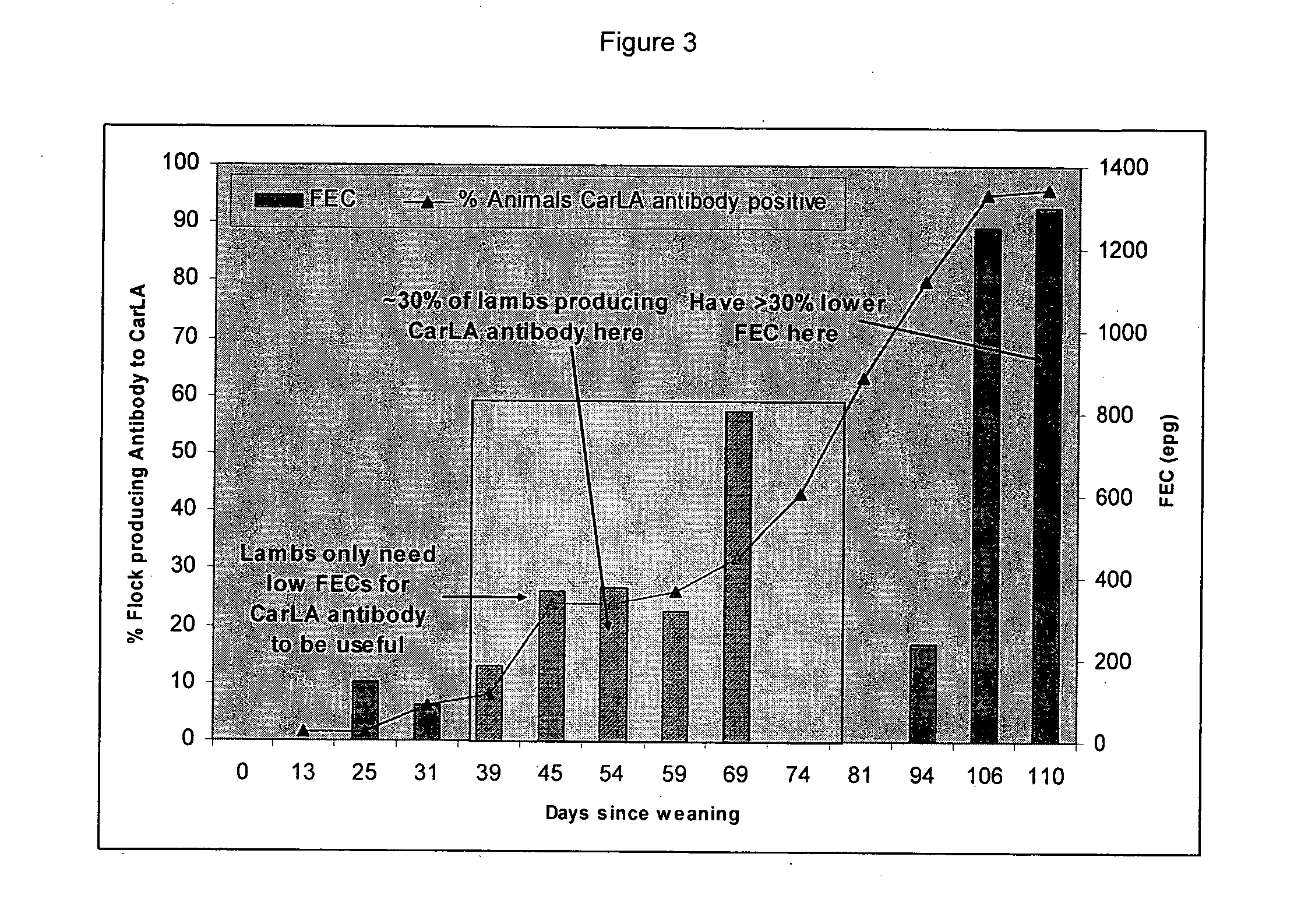Methods of selecting host resistant animals
a technology of resistant animals and host, applied in the field of methods, can solve the problems of cost reduction of animal performance, death of animal, costing the new zealand sheep industry more than twenty million dollars annually in lost productivity, and achieve the effect of less parasite resistan
- Summary
- Abstract
- Description
- Claims
- Application Information
AI Technical Summary
Benefits of technology
Problems solved by technology
Method used
Image
Examples
example 1
Materials and Methods
[0183]Lambs grazed on open pasture were exposed to 2-4 cycles of nematode challenge whereby the FEC was allowed to build up to 800-1000 epg before the animals were faecal sampled and drenched.
[0184]All lambs had saliva collected by using the saliva sampling set-up shown in FIG. 1, whereby a cotton roll (1), held by forceps (2) was inserted into the mouth of the lamb between the cheek and the jaw, and the cheek massaged for around 15 seconds. The cotton roll was placed in a bar-coded vial (3), and the animal's identity tag scanned using an EID reader (5), and the bar-coded vial read by a barcode reader (4). The EID and bar-coded sample were matched using a Tru-Test XR3000 system. This set-up allows the sample to be directly traced to the animal from which it was taken.
[0185]The saliva was then collected by centrifuging the cotton roll and the saliva diluted with a buffer containing a preservative. The diluted saliva was then contacted with a multi-well plate coat...
example 2
Materials and Methods
[0195]Rissington Breedline Highlander lambs (n=299) were grazed on nematode infected pasture and randomly sampled (n=30) for saliva, serum and faeces at weekly intervals. The whole flock was then sampled for saliva, serum and FEC. At this time the animals were weighed and dag scored. (Sampling 1). This was repeated five to eight weeks later. (Sampling 2). All weekly and sampling 1 and 2 saliva and serum samples were assayed for CarLA specific IgG1 IgE and IgA by EUSA.
Results
[0196]Approximately 40% of the flock tested positive for CarLA IgG1 antibodies in their saliva. This increased significantly by the end of the trial so that all the animals were producing detectable levels of IgG1 antibody to CarLA in saliva. Compared to the results in example 1, the increase in reactivity was probably due to the stronger and earlier nematode challenge.
[0197]The saliva IgG1 and IgA results in both sampling 1 and 2 correlated with reduced FEC at the second sampling (FEC2). In ...
example 3
Materials and Methods
[0201]Rissington Breedline Highlander lambs (n=315) were saliva sampled at weaning [Sampling 1] before being grazed on open pasture. Weekly random sampling of the flock (n=50) for saliva and faecal egg count samples (when appropriate) began at week 2. The whole flock was sampled for saliva at week 8 [Sampling 2] and at week 16 [Sampling 3].
[0202]The whole flock was also sampled for FEC at week 8 (FEC1a, mean epg 785 (arithmetic)) and week 9 (FEC1b, mean epg 821). Following sampling at week 9, the lambs were drenched and crutched.
[0203]A second round of sampling for FEC occurred at week 17 (FEC2a, mean epg 332), week 18 (FEC2b, mean epg 330) and week 19 (FEC2c, mean epg 365). Following sampling at week 18, the lambs were weighed and dag scored. All weekly and Sampling 1, 2 & 3 saliva samples were assayed for CarLA specific IgG1 and IgA by ELISA.
[0204]Similar saliva and FEC sampling was also carried out on recorded flocks of Perendale, Coopworth and Romney lambs.
[...
PUM
| Property | Measurement | Unit |
|---|---|---|
| time | aaaaa | aaaaa |
| time | aaaaa | aaaaa |
| time | aaaaa | aaaaa |
Abstract
Description
Claims
Application Information
 Login to View More
Login to View More - R&D
- Intellectual Property
- Life Sciences
- Materials
- Tech Scout
- Unparalleled Data Quality
- Higher Quality Content
- 60% Fewer Hallucinations
Browse by: Latest US Patents, China's latest patents, Technical Efficacy Thesaurus, Application Domain, Technology Topic, Popular Technical Reports.
© 2025 PatSnap. All rights reserved.Legal|Privacy policy|Modern Slavery Act Transparency Statement|Sitemap|About US| Contact US: help@patsnap.com



